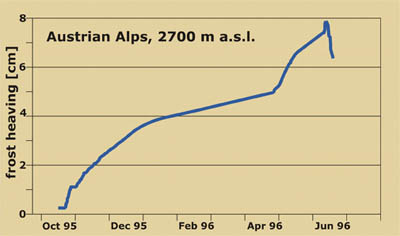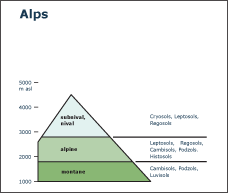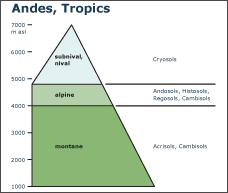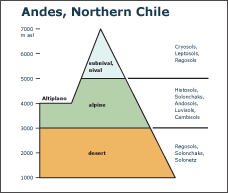 |
|
|
|
|
|
Climate, as a soil formation factor, plays a major role at different scales. On the global scale, alpine mountain areas reach from arctic to tropical regions, with varying temperature, precipitation, insolation, etc. On the local scale, the variance of the meteorological conditions in an alpine region leads to a vertical zonation into altitudinal belts of climate and vegetation. These microclimates influence many soil processes. |
| |
|
|
1 - General trend of air and soil temperature |
|
Due to the high proportion of direct radiation, the aspect of the slopes plays an important role in controlling soil temperature.
|
|
2 - Influence of aspect on soil temperature: example from the Austrian Alps |
| |
|
Temperatures below 0 °C, due to seasonal or diurnal changes, lead to different frost-related phenomena, clearly influencing soil evolution and vegetation. Generally, frost-related movements of the substrate occur vertically (frost heave) and downslope (solifluction). Frost heaving Fig. 3 indicates frost heaving, the vertical movement of frost, at 2700 m in the Austrian Alps. The uplifting of the topsoil starts in fall, when soil temperature drops below 0 °C. The ongoing process results in frost heaving of 5 cm during winter (until End of April). With the beginning of the snow melt, percolating water adds to soil-ice and leads to an increase in volume, therefore uplifting the topsoil again about 2.5-3 cm. Overall, frost heaving of almost 8 cm results in winter, which greatly influences downslope movements of the topsoil and root-growth of the alpine plants. |
3 - Frost heaving: example from the Austrian Alps
|
|
Solifluction is a slow, downward flow of water-saturated soil. It is promoted by the existence of permafrost, which traps snow and ice melt within the surface layer making it more fluid. The whole surface layer tends to move together as a cohesive mass, well illustrated in Fig. 4. |
4 - Solifluction lobes |
| |
|
Altitudinal zones under different climates
|
|
29 August 2011 |
||
| |
||




